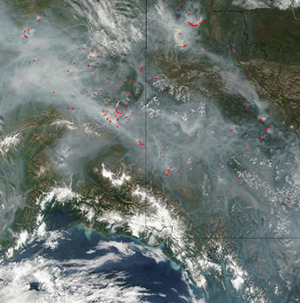|
||

|
||
Smoke from Agricultural and Forest Fires Fires and smoke across Alaska and Northern Canada August 21, 2004, Archive Image courtesy of NASA Modis Tools for Locating Active Wildfires Near You
Health Resources
Wildfire Resources
If you are healthy, you're usually not at a major risk from short-term exposures to smoke. Still, it's a good idea to avoid breathing smoke if you can help it. Smoke is made up of a complex mixture of gases and fine particles produced when wood and other organic matter burn. The biggest health threat from smoke comes from fine particles. These microscopic particles can get into your eyes and respiratory system, where they can cause health problems such as burning eyes, runny nose, and illnesses such as bronchitis. Fine particles also can aggravate chronic heart and lung diseases - and even are linked to premature deaths in people with these conditions. How to Protect Your Family from the Health Effects of SmokePay attention to local air quality reports and stay alert to any news coverage or health warnings related to smoke. Use common sense. If it looks smoky outside, it's probably not a good time to mow the lawn or go for a run. And it's probably not a good time for your children to play outdoors. If you are advised to stay indoors, take steps to keep indoor air as clean as possible. Keep your windows and doors closed - unless it's extremely hot outside. Check the Air Quality Index (AQI) forecast for your area. The AQI, based on data from local air quality monitors, tells you about the daily air quality in your area and recommends precautions you can take to protect your health. As smoke gets worse, the concentration of particles in the air changes - and so do the steps you should take to protect yourself. Visit AIRNow for local forecast and conditions. Run your air conditioner, if you have one. Keep the fresh air intake closed and the filter clean to prevent bringing additional smoke inside. Note: If you don't have an air conditioner, staying inside with the windows closed may be dangerous in extremely hot weather. In these cases, seek alternative shelter. Help keep particle levels inside lower. When smoke levels are high, try to avoid using anything that burns, such as wood fireplaces, gas logs, gas stoves - and even candles! Don't vacuum. That stirs up particles already inside your home. And don't smoke. That puts even more pollution in your lungs, and in the lungs of people around you.If you have asthma or other lung disease, make sure you follow your doctor's directions about taking your medicines and following your asthma management plan. Call your doctor if your symptoms worsen. If you have heart or lung disease, if you are an older adult, or if you have children, talk with your doctor about whether and when you should leave the area. When smoke is heavy for a prolonged period of time, fine particles can build up indoors even though you may not be able to see them. |